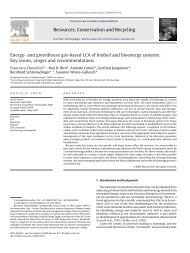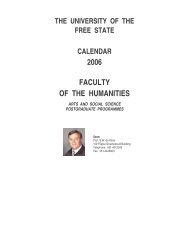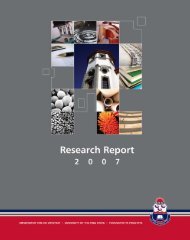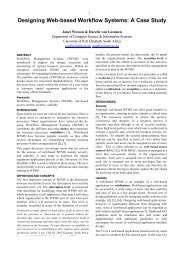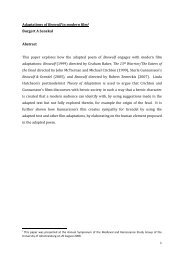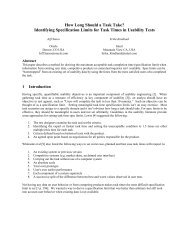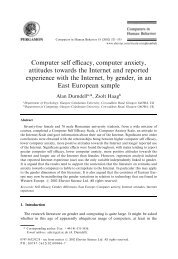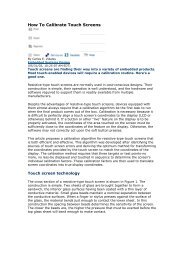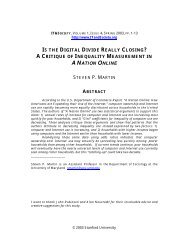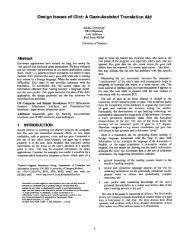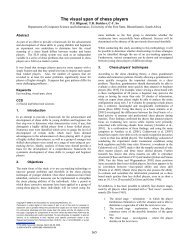the role of livestock in developing communities: enhancing ...
the role of livestock in developing communities: enhancing ...
the role of livestock in developing communities: enhancing ...
You also want an ePaper? Increase the reach of your titles
YUMPU automatically turns print PDFs into web optimized ePapers that Google loves.
A household economics perspective and <strong>livestock</strong> development<br />
Poor rural households are cont<strong>in</strong>uously <strong>in</strong>volved <strong>in</strong> a struggle to make ends meet; food security and family<br />
livelihood expenses be<strong>in</strong>g some <strong>of</strong> <strong>the</strong> major priorities. Livestock production could play a vital <strong>role</strong> <strong>in</strong> this<br />
context: directly through food provision, for example meat, milk, eggs; and also <strong>in</strong>directly by streng<strong>the</strong>n<strong>in</strong>g<br />
<strong>the</strong> household-economy through <strong>the</strong> provision <strong>of</strong> draught power, organic fertiliser and fuel, hides, commercial<br />
sales <strong>of</strong> animals and animal products and also through occasional sales to meet particular community<br />
and household needs such as school fees, celebrations, funerals, marriages, etc. The real contribution <strong>of</strong><br />
many <strong>of</strong> <strong>the</strong>se <strong>livestock</strong> products are however generally not accurately valued by <strong>the</strong> monetary yardstick<br />
alone.<br />
In this context <strong>the</strong> design <strong>of</strong> <strong>livestock</strong> commercialisation projects should be considered carefully: both<br />
from a susta<strong>in</strong>able bus<strong>in</strong>ess view; and also <strong>in</strong> context <strong>of</strong> <strong>the</strong> wider set <strong>of</strong> parameters driv<strong>in</strong>g <strong>the</strong> household<br />
economic system. Market prices alone will seldom provide realistic project value <strong>in</strong>dicators. Opportunity<br />
costs, social cost- benefit analysis, shadow prices and hedonistic pric<strong>in</strong>g models should be considered to<br />
determ<strong>in</strong>e potential impacts <strong>of</strong> project <strong>in</strong>terventions <strong>in</strong> general and more particularly on <strong>the</strong> participat<strong>in</strong>g<br />
households and <strong>the</strong>ir real <strong>in</strong>centives to collaborate.<br />
An <strong>in</strong>itiative to enhance <strong>livestock</strong> production <strong>in</strong> develop<strong>in</strong>g <strong>communities</strong> could, for example, be to reduce<br />
<strong>in</strong>fant <strong>livestock</strong> mortality – a very high opportunity cost factor <strong>in</strong> cattle, sheep and goat farm<strong>in</strong>g. The impact<br />
on <strong>the</strong> various households <strong>in</strong> <strong>the</strong> target community may however differ considerably, with certa<strong>in</strong><br />
households <strong>in</strong> a better position to benefit directly by expand<strong>in</strong>g <strong>the</strong>ir herds, while o<strong>the</strong>rs are made worse<br />
<strong>of</strong>f due to <strong>in</strong>creased pressure on <strong>the</strong> common graz<strong>in</strong>g resources. Environmental impacts related to subsequent<br />
<strong>in</strong>creased numbers vis-à-vis graz<strong>in</strong>g rates and veldt types have to be considered. Market<strong>in</strong>g systems<br />
must also be <strong>in</strong>troduced to enable <strong>the</strong> commercialisation <strong>of</strong> <strong>the</strong> <strong>in</strong>creased <strong>of</strong>f-take. Distributional impacts,<br />
<strong>in</strong> particular on gender positions, should also be considered when such <strong>in</strong>terventions are designed/appraised/<br />
evaluated.<br />
The wider impact at community level must also be traced. If sound knowledge <strong>of</strong> <strong>the</strong> work<strong>in</strong>gs <strong>of</strong> <strong>the</strong><br />
applicable ‘<strong>livestock</strong> typology’ and <strong>the</strong> relationship with participat<strong>in</strong>g households exists, a development<br />
trajectory for <strong>the</strong>se different household types with<strong>in</strong> this broader typology can be considered. The l<strong>in</strong>kup<br />
between typology and household is thus important to plan successful project <strong>in</strong>terventions. The development<br />
<strong>of</strong> susta<strong>in</strong>ability <strong>in</strong>dicators for specifically assess<strong>in</strong>g <strong>the</strong> contribution <strong>of</strong> animal production to <strong>the</strong><br />
quality <strong>of</strong> life <strong>of</strong> <strong>communities</strong> needed to be <strong>in</strong>vestigated.<br />
Diversity, typologies and farm<strong>in</strong>g types<br />
In a recent study on <strong>the</strong> <strong>role</strong> <strong>of</strong> ‘small stock farm<strong>in</strong>g’ <strong>in</strong> <strong>the</strong> rural based Leliefonte<strong>in</strong> community <strong>in</strong> <strong>the</strong><br />
Nor<strong>the</strong>rn Cape prov<strong>in</strong>ce <strong>of</strong> South Africa, Salome Modiselle (2005), after liv<strong>in</strong>g <strong>in</strong> <strong>the</strong> community for a<br />
considerable time dur<strong>in</strong>g her research, concluded that diversity <strong>in</strong> <strong>the</strong> <strong>role</strong>s <strong>of</strong> <strong>livestock</strong> at <strong>the</strong> household<br />
level required <strong>the</strong> recognition <strong>of</strong> a range <strong>of</strong> farm<strong>in</strong>g types, <strong>in</strong> order to design realistic and more effective<br />
development <strong>in</strong>tervention strategies. The construction <strong>of</strong> a <strong>livestock</strong> farm<strong>in</strong>g typology, describ<strong>in</strong>g at least<br />
six different types <strong>of</strong> <strong>livestock</strong> farm<strong>in</strong>g/hold<strong>in</strong>g models <strong>in</strong> operation <strong>in</strong> <strong>the</strong> community and rang<strong>in</strong>g from<br />
susta<strong>in</strong>ed commercial production to ‘status herd<strong>in</strong>g’ and food security, was considered necessary <strong>in</strong> this<br />
community to give effect to <strong>the</strong> required support and developmental <strong>in</strong>terventions. This <strong>in</strong>stitutional <strong>in</strong>novation<br />
departed radically from a ‘Taylorian type’ extension strategy, where ‘one-fits-all’ technological<br />
solutions were favoured by <strong>the</strong> government extension agencies.<br />
A similar ‘typology development approach’ was proposed and implemented <strong>in</strong> <strong>the</strong> Eastern Cape wool<br />
growers project, where shear<strong>in</strong>g sheds were, as a result, successfully extended and converted <strong>in</strong>to <strong>livestock</strong><br />
community mobilis<strong>in</strong>g and support centres, with good effect, to cater for <strong>the</strong> multifunctional nature <strong>of</strong><br />
<strong>livestock</strong> production <strong>in</strong> <strong>the</strong> target <strong>communities</strong> (D’Haese et al, p. 14).<br />
Proceed<strong>in</strong>gs <strong>of</strong> <strong>the</strong> Satellite Symposium: WCAP 5



